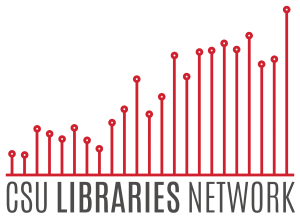Unified Library Management System: One platform, 23 campuses
This article was written by CSU Libraries on October 14th, 2014.
The Unified Library Management System, or ULMS, is a next-generation platform that would bring together library technology for all 23 California State University campuses. Currently, each campus has about three to five different information resource management systems, many that don’t talk with each other or with the other campuses.
The ULMS would change all that.
Right now, the CSU Council of Library Deans, with the backing of the Chancellor’s Office, is preparing to put out a request for proposals for the technology to link their libraries. After taking stock of their options, they hope to choose a system that will connect their separate CSU campuses through powerful cloud-based computing.
‘To ensure equity across all campuses’
The goal is to not just make research easier for library users, but also to ensure equity across the campuses, said Gerry Hanley, assistant vice chancellor for academic technology services at the CSU. Hanley is championing the project at the Chancellor’s Office.
“I think the big important issue is to ensure equity across all campuses, to every student and faculty and staff to have equally successful and powerful library services, whether you’re on a big campus, a small campus, a rich campus or a poor campus,” Hanley said.
The ULMS will ensure that equity by becoming the source for electronic resources for every campus. It will also help library staff manage print collections and assess user data, giving the CSU a broader picture of what resources are in demand.
Going door-to-door and getting feedback
In order to get all the universities on board, ambassadors of the platform have been visiting campuses, to answer questions. Two of those ambassadors, Systemwide Library Services Director David Walker and Sonoma State Interim Library Director Brandon Dudley, toured 13 CSU campuses to share the vision.
The goal was to explain the platform and garner support, as well as assess individual campus’ concerns and needs, Dudley said. The reaction was overwhelmingly supportive.
“All the campuses are different,” Dudley said. “They’re in different cycles with their current products. They’re in different phases of growth in life. Some have had recent changes in management. The reactions were positive. Some were ready to go tomorrow with a new system; others had a more cautious attitude about it.”
Even the more cautious campuses, however, saw the benefits of a unified platform, Walker said.
“I think people really wanted to express to us their concerns, their issues, things they want to make sure that we factor into the decision. But overall, I think it’s been very positive, and the library directors in particular have been very positive about this project,” Walker said.
Looking to other models
There are several consortia pursuing collaborative platforms similar to the ULMS vision.
The group that is perhaps furthest along is the Orbis Cascade, a mix of large state schools, community colleges and small, private institutions in the Pacific Northwest. Orbis Cascade is in the process of migrating its libraries over to their Shared Inter-Library Services, or Shared ILS.
Their experience of moving through the request for proposals process and selecting a platform has been a reference for the CSU, Hanley said.
“We’ve been talking with them about how they approached it and how they’re supporting it and being successful at what they’re doing,” Hanley said.
‘You’ve got to pay the mover’
Of course, once a system has been selected, the process of migrating all of the libraries’ data begins.
“There’s a cost to implementing it because you’ve got to move data from one place to another,” Hanley explained. “You have to make sure literally the almost billion records of resources we have get managed properly. Think about when you’re moving from one house to another, you’ve got to pay a mover, right?”
To that end, the Chancellor’s Office has invested $1 million to support this new initiative. That $1 million, Hanley says, is sort of like the moving costs for the first group of campuses.
A portion of that money will then be used to “pay the mover,” said Hanley, and transfer the first few campuses to the platform. In the end, the system may pay for itself, by lightening staff workloads and eliminating the need to license many different programs.
Then libraries will be empowered to do what they do best: providing information resources to their users as easily and efficiently as possible.
More information:

